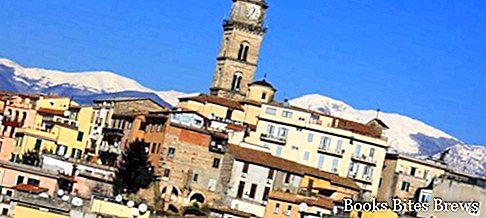What to see in Frosinone, an itinerary including the main monuments and places of interest, including the Archaeological Museum, the Cathedral of Santa Maria Assunta, the Church of San Benedetto and the Parco delle Colline.
Tourist information
Important commercial and industrial center, Frosinone is considered by many to be the capital of Ciociaria.
This city of southern Lazio is located on a hill, in a dominant position on the valley of the Sacco river, between the Ernici Mountains in the north and the Lepini Mountains in the east, furthermore, looking in the distance to the south, you can see the Ausoni Mountains.
Some archaeological remains discovered in the area provide important evidence of the presence of very ancient settlements in the area, including handmade objects made of stone, dating back to the lower Paleolithic era and found at the Selva dei Muli locality.
In this regard, it is worth visiting the archaeological museum of Frosinone, in which three sections can be visited, the first dedicated to prehistory and protohistory, containing important finds from the Paleolithic and iron age pottery, the second dedicated to the archaic age , with various volsci, hernic and etruscan remains found throughout the province, and the third dedicated to the Roman age, with an exposition of the history of ancient Frusino and of the archaeological evidence concerning it.
The Cathedral of Santa Maria Assunta, located at the highest point of the historic center, was heavily remodeled in the eighteenth century, inspired by the Church of Sant'Andrea della Valle in Rome.
The Romanesque bell tower, city symbol, is 68 meters high and has three rows of double lancet windows, while the facade of the Cathedral is made of white marble.
Among the works of art preserved inside the building of worship, it is worth mentioning a Madonna with Saint Anna, San Giovannino and angels, a masterpiece by Sementi.
What see
The abbey church of San Benedetto, dating back to 1134 and home to an ancient art gallery, was rebuilt between 1750 and 1797 in late Baroque style, with an octagonal lantern and a facade with two superimposed orders.
The interior of the church has a single nave, with intercommunicating side chapels and roofing with a ribbed barrel vault, stuccoed and lunette at each window.
There are remarkable paintings on canvas, dating back to the period between the seventeenth and nineteenth centuries.
Recommended readings- Anagni (Lazio): what to see
- Lazio: Sunday day trips
- Vetralla (Lazio): what to see
- Ciociaria (Lazio): what to see in the historic region
- Alatri (Lazio): what to see
Among these it is possible to admire the painting of the Madonna del Buon Consiglio, a work by an unknown local artist, to which a prodigy which occurred on 10 July 1796 would be linked.
On that date, while the recitation of the rosary was underway by some women gathered in front of the painting, the Madonna depicted opened her eyes, directing her gaze towards the faithful, then her face changed color becoming vermilion and her left eye who looked at the Child veiled with tears.
Under the altar, which is decorated with Baroque stuccos and dedicated to the Kambo family, there are the remains of a martyr of Christianity.
Going up on the small bell tower you can observe closely the two bells of the ancient Cacciavillani factory and the bell of the ancient municipality with the coat of arms of the city of Frosinone.
To see the Parco delle Colline, where there is an archaeological area and a space for children.
In past epochs, handmade ropes were produced in the area and for this reason the place was also known as the area of the ropes.
In honor of this ancient tradition, a walkway was created, called the Path of the Funari, with the aim of reproducing the ancient path that the rope builders followed.
In addition, the statue of the Madonna of the Rosary was placed inside the park, the work of the sculptor Tommaso Gismondi.




